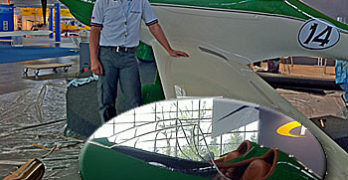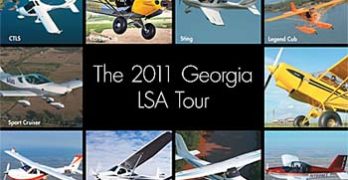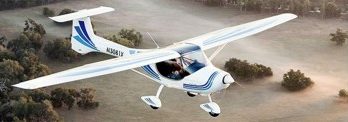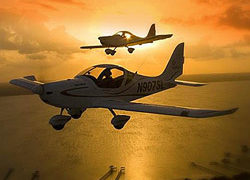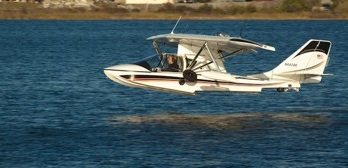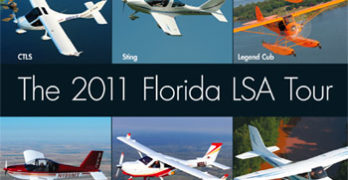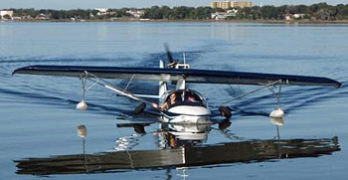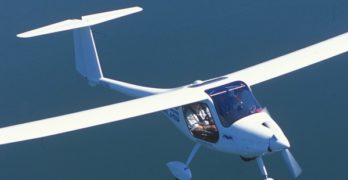The major European Airshow, Aero, opened this morning with the usual unveiling of new designs but one aircraft appeared to be the center of attention. Peter Funk had an idea five years back but shelved it for other projects. Now the time is right for his distinctly retro treatment of one of Light-Sport aviation’s sharpest designs, the Fk14 Polaris (Alert readers will identify Polaris as the Cirrus SRS, that GA company’s onetime entry in the LSA sweepstakes.) *** Even experts accustomed to following the latest in new or updated designs were caught off guard by the unorthodox entry (photo). With dual windscreens and race car bodywork, the open cockpit creation charmed many who gained early access to the great exhibit halls of Aero… 11 of them, each the size of a gymnasium. While exhibitors were assembling their displays Fk Lightplanes’ staff grabbed lots of attention with their Fk14 Lemans. *** Constrained by their ongoing contract with Cirrus until the end of the year, Fk Lightplanes sought permission before revealing Lemans and sales will not happen in 2011.
Search Results for : flight design ct
Not finding exactly what you expected? Try our advanced search option.
Select a manufacturer to go straight to all our content about that manufacturer.
Select an aircraft model to go straight to all our content about that model.
LSA Tour Heads North After Sun ‘n Fun 2011
The flying entourage has grown from five brands the first time around to a total of 10 Light-Sport Aircraft including: TL Sting, TL Sirius, Zlin iCub, Legend Cub, Rans S-19, Flight Design CTLS, CSA SportCruiser, Jabiru J-230, Remos GX, and CubCrafters (SportCub). This flock includes several of the best-selling LSA. *** Following on the success of January’s Florida LSA Tour, the idea is to bring the show to the people. The truth is most pilots cannot attend every airshow for a variety of reasons. Even though the LSA concept has generated a lot of attention inside aviation over the last six years, the fact remains that, “most pilots in the country have yet to even see a LSA,” to quote industry leader, Tom Peghiny of Flight Design USA.
Aviation Jobs, American Style
Good news from Allegro LSA’s head honcho Doug Hempstead, as he spoke with Plane & Pilot publisher Mike McMann. *** Allegro, now a solely-American made, composite/aluminum SLSA (my flight report is due out soon in the magazine) told Mike he expects to hire as many as 35 workers within the next year. These are jobs that were formerly held by Czech Republic personnel. *** Allegro is a Czech-designed airplane (Fantasy Air) that, like so many LSA, was built in Czech Republic and assembled, test flown and delivered in the States. *** Doug and his wife Betty bought the rights to produce the airplane here and production is now underway at the company’s Sanford, NC plant. *** More than 450 of the Kevlar-composite fuselage/aluminum wing Allegros have been sold since 1994, mostly overseas. The Hempsteads hope to change that proportion…and employ more Americans in the process. *** Three Allegro models are offered: Classic Trainer at $89,000 (also configurable as an IFR trainer), Voyager at $94,000 (adds things like MGL Voyager EFIS, Garmin radio and transponder and vertical card compass), and Executive at $99,000 (adds two Dynon Skyview Synthetic Vision displays).
What Big GA Thinks about Young LSA
I often tell reporters and others that we must all keep in mind that Light-Sport aviation is an industry only six years old, a mere toddler in the realm of general aviation. In that time we’ve seen an astonishing development of all kinds of flying machines, 115 models deep. And this while industry had to write its own certification standards, establish dealer networks, build up supply chains to customers needing parts… from all over the globe, and much more. Contrarily, general aviation is many decades old and most of these systems have been established. *** Those GA folks, with all their experience, offer a way to help LSA grow and mature. LSA producers can learn a lot from these veterans. With that in mind, it may be interesting to hear a few comments from GA leaders. *** In an AIN Online article, writer Matt Thurber begins noting that experts ask the question, “[Is] general aviation (GA)… declining or poised for a renaissance generated by new interest in light sport aircraft (LSA) and avionics technology?” In a thorough response to the inquiry, Thurber cites the following general aviation aircraft production numbers: In 2009 only 1,587 aircraft were shipped, according to GAMA statistics, down from 3,029 in 2008 and a record 3,279 in 2007 (since a high of almost 18,000 aircraft in 1978).
Remos: New Dealer & Boy Scout Pow-Wow
Remos continues to build its U.S. sales/service network. The company just “promoted” Tom Pekar’s Success Aviation, near Houston, from a Pilot Center to it’s 16th Aircraft Dealer in the U.S. *** The new dealer has two Remos GX demos, one with an autopilot. Both are used in the school. *** “Most flight training operations involving the GX use about 3.2 gallons of fuel,” he says, “compared to over 5 in a Cessna 152 and close to 9 in a Skyhawk.” *** With the price of avgas jumping up the way it has been of late, flight schools nationwide have to at least be giving renewed thought to adding LSA trainers to their fleets. *** One of the tangible bonuses the GX brings to its quality build and superb handling characteristics (my personal view: it’s as sweet to fly as any LSA out there) is its capability of flying with the doors off.
Hot Off The Water
To the answer “Progressive Aerodyne!” comes the Jeopardy question, “What LSA company thumbs its nose at the bad economy?” *** Certainly one of the most-fun LSA flights I’ve had in some time came at the controls of that company’s SeaRey amphibian.My LSA pal Dan Johnson recently wrote up a piece on the amphib which spurred me to excerpt some highlights in advance of my own flight report on the lively sea bird coming soon in Plane & Pilot magazine. *** Wayne and Kerry Richter, second and third generation founders of Progressive Aerodyne, started back in the ‘70s with many memorable UL birds they created with dad/grandfather Stanley Richter. The company then was Advanced Aviation and it put out, among other craft, several iterations of a very popular ultralight amphib: the Buccaneer.Building on that success, as Dan notes, Progressive Aerodyne popped out 31 Experimental Amateur Built kits in 2010.
Sebring’s Over… but Next: Florida LSA Tour
Every now and then the marketing geniuses in Light-Sport aviation have an exceptionally good idea. Here’s one of them. Initially organized by SportairUSA’s Bill Canino and now-American Legend marketer Dave Graham (formerly of Gobosh), a flock of planes including five of the most popular brand names will set off for Sebring-After-Sebring… or what they are calling The 2011 Florida LSA Tour. *** “We’re in Florida already and we have to fly home through the state after Sebring ends,” explained Canino. “Since everyone can’t come to Sebring, we thought we’d take the show to them.” *** Bill and Dave established a strategically-planned series of stops, contacted EAA chapters at several locations and asked them for an invitation, and offered them a cash incentive to assist with pulling out the members for the date of arrival. I hope this works well as it’s a grand idea in the LSA tradition of open and friendly competition.
SeaRey Sales Prove Popularity of Amphibians
Progressive Aerodyne and their popular SeaRey amphibian represent a current-day success sufficient to generate envy in most airframe sellers. Consider these results: Searey delivered 31 kits in 2010, an average 2.5 per month during a lousy year. Plus, in just three weeks since Sebring another 14 SeaRey kits have been ordered, upping the monthly average to 4.0. True those SeaReys are Experimental Amateur Built (EAB) kit models and so don’t compare directly with SLSA sales. *** In less than three years, company spokesman and sales director Darrell Lynds (formerly with SportairUSA) took the company from one kit a month to its current pace, along the way building a list of 1,700 very interested potential buyers. He says his 2011 orders are cash-in-hand and projects a solid year for the amphibious seaplane producer. This adds to a remarkably loyal following of 600 SeaRey aircraft builders. How can the central Florida manufacturer be doing so well?
Flying Cessna’s LSA Skycatcher
Honestly, I never thought I’d see this day arrive. As I started work
on a Cessna aircraft review for the pages of Light Sport and
Ultralight Flying magazine, I thought, We’ve come a long way.
When this publication was started 35 years ago, it was titled Glider Rider
and it featured hang gliders. Coverage then expanded to include powered
ultralights, and now light-sport aircraft (LSA) are included in the mix.
This month I’ve written a pilot report on Cessna Aircraft’s Skycatcher
LSA, the first Cessna in modern memory not built to FAR Part 23 standards,
that is, not type-certified by the U.S. government. Some may say ultralights
“grew up” to become light-sports. But I say that Cessna has moved
(returned?) to very light aircraft designs. I consider their arrival significant.
It isn’t simply that you can buy a brand-new Cessna for $112,500 (more on
the price later). The more important point to Light Sport and Ultralight
Flying readers is that the Skycatcher flies similarly to what light aircraft
enthusiasts fly.
Sleek, Comfortable and Fun; The Sinus Motorglider
Many Americans will agree
the name of this aircraft is odd, and that may be a kind word for the common reaction to “Sinus.” Is the name that important? Sinus (pronounced Seen-us), the aircraft, is a sleek, slender machine capable of impressive performance.
Any soaring-attuned pilot can easily live with the name Sinus for the 49-foot span and, get this, 28-to-1 glide performance! On first glance, except for its elegant, shapely, and thin wings, the Sinus looks like a proper light sport airplane. Pilot Matevz Lenarcic flew one around the world solo, in 80 days, and with zero ground or air support (see “Microlight Motorglider Flies Around the World,” April ’05 UltralightFlying! magazine).
What’s In a Name After All?
Let’s consider that name. U.S. dealer Robert Mudd says Pipistrel – the manufacturer – prefers to pronounce it “seen-us,” not “sighn-us.” They say this refers to a perfect sound wave or sine wave rather than a head cold.
- « Previous Page
- 1
- …
- 102
- 103
- 104
- 105
- 106
- …
- 145
- Next Page »


